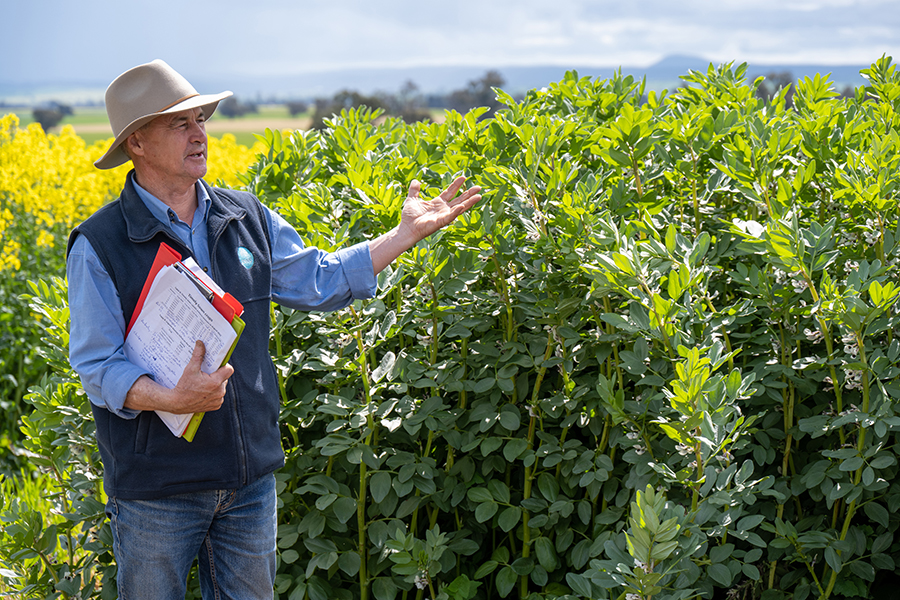In brief
- Experiments have verified that multiple weed management tactics are needed to effectively manage severe annual ryegrass infestations within three years
- Researchers explored break crops, field pea brown manuring, cutting wheat for hay and weed-free winter fallows for their effectiveness in reducing in-crop annual ryegrass infestations and annual ryegrass seedbanks in the soil
- Double breaks consisting of either two broadleaf crops or canola followed by cereal hay depleted the annual ryegrass seedbank and represented some of the most-profitable farming systems
Farming systems experiments have confirmed the value of using a ‘double-break’ crop sequence to help drive down the population of weeds and disease pathogens in crops.
A double-break crop sequence is one in which two broadleaf crops are grown in successive years, usually before a cereal phase.
CSIRO Agriculture and Food chief research scientist Dr John Kirkegaard told the 2023 GRDC Update at Wagga Wagga that double breaks were profitable and effective for driving down the population of annual ryegrass in badly infested paddocks (Table 1).
Table 1: Double-break crop sequences1 reduce annual ryegrass numbers.
Crop sequence | Three-year farming system financials | 20172 annual ryegrass numbers per square metre | |||
(Management intensity) | Herbicide cost | Total cost | Profit | Profit to cost ratio | |
Wheat/wheat/wheat | 59 | 317 | 388 | 1.20 | 3140 |
Wheat/wheat/wheat (aggressive) | 128 | 560 | 585 | 1.04 | 366 |
Canola/wheat/wheat | 96 | 609 | 883 | 1.45 | 219 |
Lupin/canola/wheat | 78 | 414 | 790 | 1.91 | 63 |
1. Sequence and input treatments (Eurongilly, New South Wales). 2. The initial annual ryegrass population was 1815/m2.
Source: Data adapted from Experiment 1 in Swan, A.D., et al. (2023) Crop & Pasture Science. Doi: doi.org/10.1071/CP22370
“A recently published crop sequencing experiment was established, with GRDC investment, near Eurongilly in southern New South Wales, in a paddock that had 1815 annual ryegrass plants per square metre,” he said.
“The research team led by CSIRO Agriculture and Food senior experimental scientist Tony Swan asked two questions: ‘Can we manage our way out of such a heavy infestation of annual ryegrass profitably?’ and ‘How can we do that?’”
If wheat was grown continuously and conservatively with low rates of nitrogen and inexpensive herbicides, Dr Kirkegaard said the researchers concluded they would end up in a “world of pain”, so a range of different three-year strategies was tested.
“If we stayed with continuous wheat but used more-aggressive strategies that included expensive pre-emergent herbicides, higher rates of nitrogen and higher plant density, we could reduce the weed population, but it cost more and had a low return on investment,” he said.
“Adding a canola break to the rotation improved profit and the return on investment but growing a double break (lupin/canola/wheat) had the highest return on investment and achieved the best control of the annual ryegrass weed population (Table 1).”

CSIRO Agriculture and Food senior experimental scientist Tony Swan explained the value of double-break crop sequences to growers and advisers at the Greenethorpe farming systems trial at Iandra Castle, north-east of Young, NSW. Photo: Nicole Baxter
In a recent paper on the outcomes of the research, published in Crop & Pasture Science, Mr Swan and colleagues stated that effective annual ryegrass control was achieved by using multiple weed management tactics.
“It was necessary to combine multiple control methods involving diversified rotations and practices that integrated herbicides with different modes of action and non-chemical control to substantially reduce and maintain low annual ryegrass density and seedbanks in no-till wheat-based cropping systems,” they said. The authors also stated that further gains could be achieved with harvest weed-seed control.
Disease effects
In an ongoing farming systems experiment – with GRDC, NSW Department of Primary Industries (DPI) and CSIRO co-investment – diverse rotations have also proven superior in driving down the level of crown rot inoculum.
Site manager Mat Dunn, a research officer with the NSW DPI, told the 2023 Wagga Wagga GRDC Update that where only one crown rot host was grown every second year – such as in a canola/wheat/canola/wheat rotation – the inoculum levels were reduced compared with the canola/wheat/barley sequence.
“However, the only crop sequences that reduced the crown rot inoculum to low disease risk levels were those that included a double break – such as faba bean/canola/wheat,” he said.

NSW Department of Primary Industries research officer Mathew Dunn said the only crop sequence in farming systems experiments at Urana, NSW, that reduced the crown rot inoculum to low disease risk levels were those that included a double break such as faba bean/canola/wheat. Photo: Nicole Baxter
More information: John Kirkegaard, john.kirkegaard@csiro.au; Tony Swan, tony.swan@csiro.au; Mat Dunn, mathew.dunn@dpi.nsw.gov.au
Useful resources
Read
Swan, AD et al. (2023). Crop & Pasture Science
Watch
‘Farming systems – profit over time and risk: The impact of three wet consecutive seasons’

























































